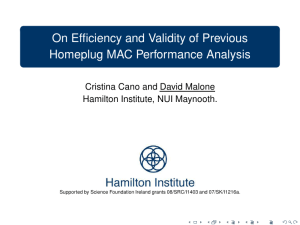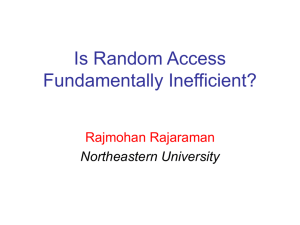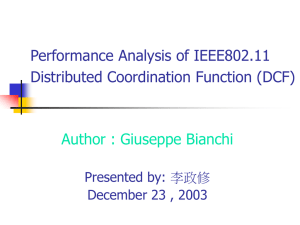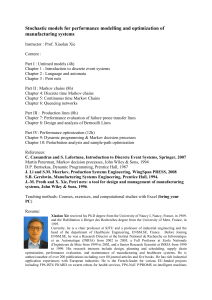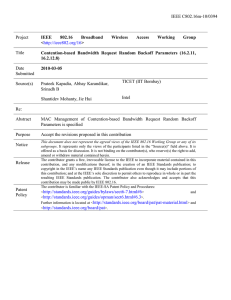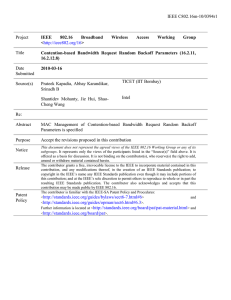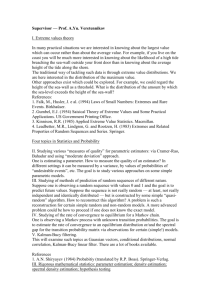Markov model for analysis and modeling of Distributed Coordination
advertisement
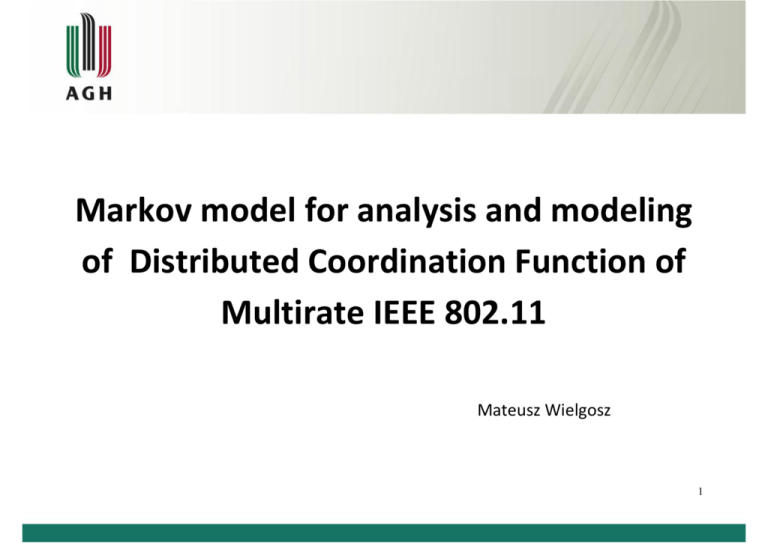
Markov model for analysis and modeling
of Distributed Coordination Function of
Multirate IEEE 802.11
Mateusz Wielgosz
1
Introduction
Distributed Coordination Function
Creating a Markov model
Solving the chain
Collision probability and Throughput
Validation
“Proper model”
Applications
Conclusion
References
2
Distributed Coordination Function (DCF)
Distributed Coordination Function is access method of MAC layer for 802.11. It deals
with transport of asynchronous best-effort traffic. It’s CSMA/CA technique.
Main attributes:
-
Sensing the medium
Using interframe spaces (IFS) timers
Using positive acknowledgements and collision avoidance approach
Executing exponential backoff algorithm
Four-way handshake
3
Distributed Coordination Function (DCF)
- Wait for channel to be idle for Distributed InterFrame Space (DIFS)
- Generate a random backoff interval (Collision Avoidance)
- Backoff time counter is decremented when cannel is idle, and frozen when
transmission is detected on the channel, and reactivated after medium is idle for
DIFS time. Transmission begins once it reaches 0.
- Transmission starts with Request To Send (RTS) frame, then waits for Clear To
Send (CTS) frame. After that payload is transmitted.
- Listening stations update Network Allocation Vector (NAV) with information from
RTS or CTS frame (period of time in which the channel will remain busy)
4
Distributed Coordination Function (DCF)
SIFS is shorter than DIFS, hence other
stations will not regard channel idle
during that time.
If both stations employ RTS/CTS
mechanism collision occurs only on RTS
frame, and is detected by lack of CTS.
Very effective in terms of system
performance (especially for large packets)
5
Exponential backoff scheme
Backoff time or Waiting Random Duration (WRD) is calculated as follows:
WRD = CW * random() * SlotTime
CW or W is called Contention Window, it’s ranging from CWmin to CWmax, after
each failure CW is doubled until reaching maximum value. CWmax=2mCWmin.
random() is random value ranging from 0 to 1.
SlotTime = minimal delay to determine the state of the channel +
+ Rx-Tx turnaround time + propagation time.
For convenience: W= CWmin, m – “maximum backoff stage”, so that Wm=2mW,
and Wi=2iW, where i ∈ (0,m) is called “backoff stage”
6
Bidimensional process
Let s(t) be stochastic process representing the backoff stage of given station.
Let b(t) be stochastic process representing backoff time counter for given station.
p – conditional collision probability. Constant and independent.
τ – stationary probability that the station transmits a packet in given slot time.
{s(t),b(t)} – bidimensional process
7
Markov Chain for the backoff window size
8
Markov Chain for the backoff window size
Pi, k | i, k 1 1
P0, k | i,0 (1 p) / W
0
Pi, k | i 1,0 p / Wi
Pm, k | m,0 p / Wm
k (0,Wi 2) i (0, m)
k (0,W0 1) i (0, m)
k (0,Wi 1) i (1, m)
k (0,Wm 1)
Pi1 , k1 | i0 , k 0 Pst 1 i1 , st 1 k1 | st i0 , st k 0
9
Obtaining closed-form solution for the chain
Stationary distribution of the chain:
bi ,k lim t Ps(t ) i, b(t ) k , i (0, m), k (0,Wi 1)
bi1,0 p bi , 0
bm1, 0 p b(1 p) m, 0
bi , 0 p i b0,0 i m
pm
bm,0
b0,0
1 p
for k ∈ (1,Wi -1):
(1 p) mj 0 b j ,0 i 0
W k
bi , k i
p bi 1,0
0im
Wi
p (bm 1,0 bm,0 ) i m
10
Obtaining closed-form solution for the chain
With previous equations and
bi , k
b b0,0 /(1 p) , we get:
m
i 0 i ,0
Wi k
bi ,0 i (0, m), k (0,Wi 1)
Wi
Now we can express all bi,k as function of b0,0 value and conditional collision
probability p. Now impose normalization condition:
m 1
Wi k m
Wi 1
(2 p) m
1
i
1 bi , k bi ,0
bi ,0
b0,0 W (2 p)
W
2
1
p
1
p
i 0 k 0
i 0
k 0
i
0
i
0
i
m Wi 1
m
Wi 1
From that:
b0,0
2(1 2 p)(1 p)
(1 2 p)(W 1) pW (1 (2 p) m )
11
Transmission probability
Probability τ that a station transmits in randomly chosen slot time:
m
bi ,0
i 0
b0,0
2(1 2 p)
1 p (1 2 p)(W 1) pW (1 (2 p) m )
p – conditional collision probability (at least one of n-1 remaining stations transmits):
p 1 (1 )n 1
Using numerical methods:
( p)
2
1 W pW im11 (2 p)i
τ (p) - continuous and monotone function.
12
Throughput
Ptr – there is at least one transmission
Ptr 1 (1 )n
Ps – transmission occurring on the channel is successful
n (1 ) n 1 n (1 ) n 1
Ps
Ptr
1 (1 ) n
S – normalized system throughput, fraction of time the channel is used to successfully
transmit payload bits:
𝑆=
𝐸[𝑝𝑎𝑦𝑙𝑜𝑎𝑑 𝑖𝑛𝑓𝑜𝑟𝑚𝑎𝑡𝑖𝑜𝑛 𝑡𝑟𝑎𝑛𝑠𝑚𝑖𝑡𝑡𝑒𝑑 𝑖𝑛 𝑎 𝑠𝑙𝑜𝑡 𝑡𝑖𝑚𝑒]
𝐸[𝑙𝑒𝑛𝑔𝑡 𝑜𝑓 𝑎 𝑠𝑙𝑜𝑡 𝑡𝑖𝑚𝑒]
13
Validation
14
“Proper model”
Supporting non-saturated conditions
Additional backoff stages
Unloaded stage
Packet dropping
15
Applications
Markov model provides very accurate analytical framework for computing network
throughput in 802.11. It can be extended to evaluate performance of various aspects:
-
Multirate algorithms
Frame loss due to SNR (in addition to collision induced frame loss)
Network Coding
Rate anomaly
Fairness criteria
16
Conclusion
Markov model for analysis of CDF performance:
Simple
Accurate
Allows detailed analysis of various aspects
Can be extended to support various needs
17
References
1. Giuseppe Bianchi – “IEEE 802.11 – Saturation Throughput Analysis”
2. Giuseppe Bianchi – “Performance Analysis of the IEEE 802.11 Distributed Coordination Function”
3. K. Duffy, D. Malone, D. Leith – “Modeling the 802.11 Distributed Coordination Function in NonSaturated Conditions”
4. M. Laddomada, F. Mesiti, M. Mondin, and F. Daneshgaran – “On the Throughput Performance of
Multirate IEEE 802.11 Networks with Variable-Loaded Stations: Analysis, Modeling, and a Novel
Proportional Fairness Criterion”
5. N. Dao, R. Malaney – “A New Markov Model for Non-Saturated 802.11 Networks”
6. F. Daneshgaran, M. Laddomada, F. Mesiti, M. Mondin - “Modelling and Analysis of the Distributed
Coordination Function of IEEE 802.11 with Multirate Capability”
7. D. Wong, S. Zheng C. Tham – “Performance Analysis of a Multi-Rate IEEE 802.11 MAC with Network
Coding”
8. H. Labiod, H. Afifi, C. De Santis – “Wi-Fi, Bluetooth, ZigBee and WiMax”
9. L. Kannan, N. Agarwal, M. Tacca – „A Markov Chain Model to Account for Multi-Rate Transmission
and Node Cooperative Behavior in IEEE 802.11 Data Link Protocol”
10. G. Bolch, S. Greiner, H. de Meer, K. Trivedi – “Queueing Networks and Markov Chains
18
